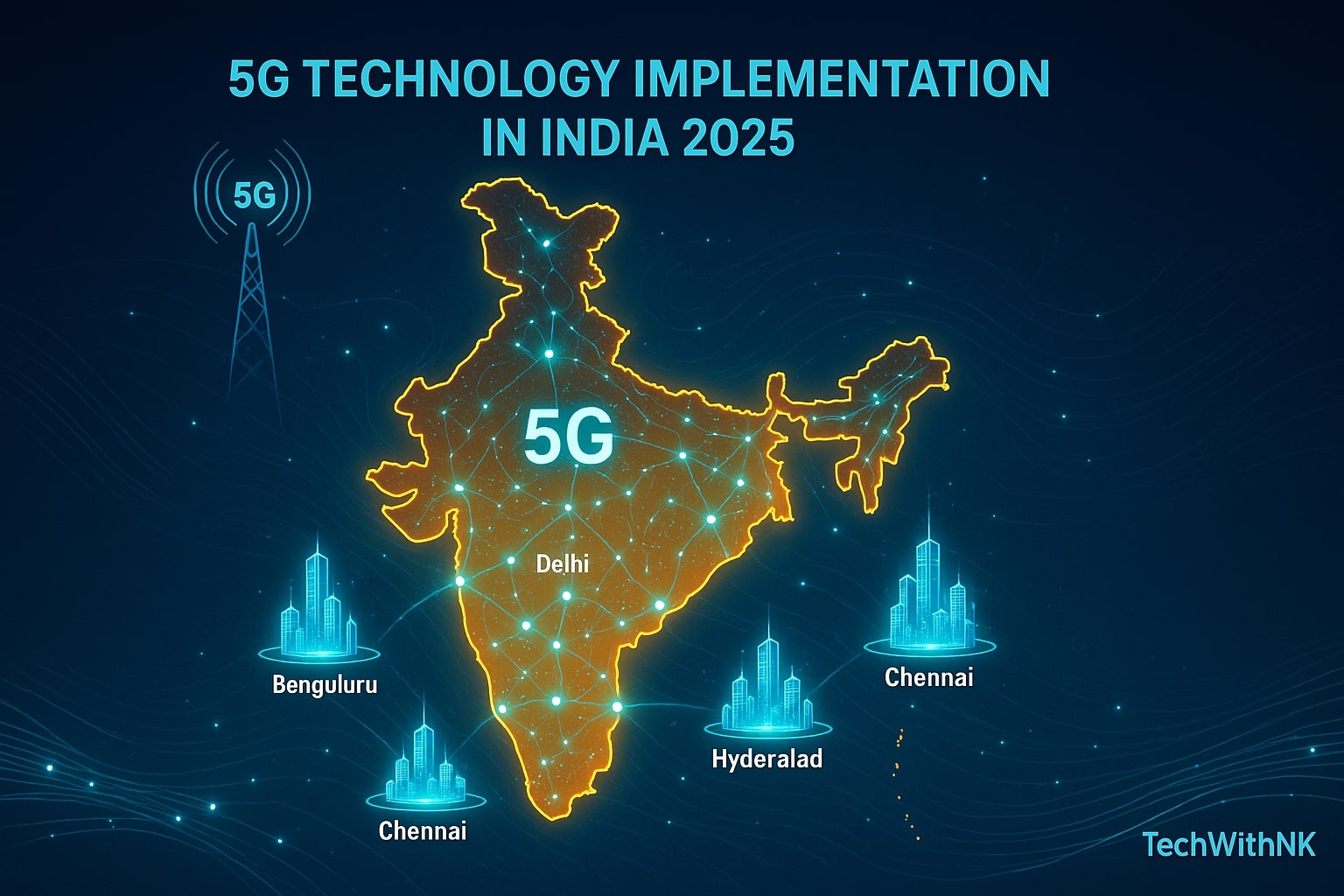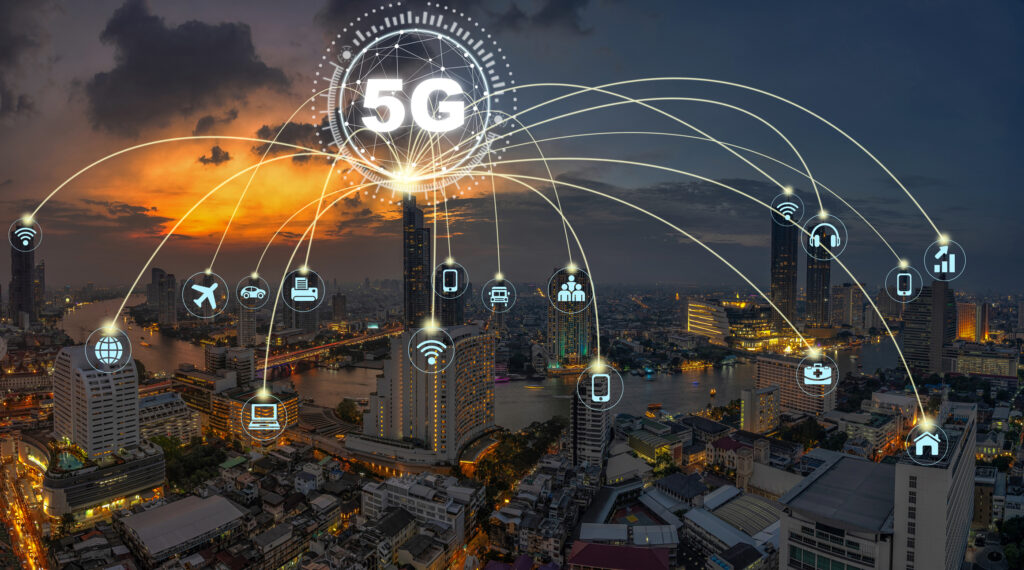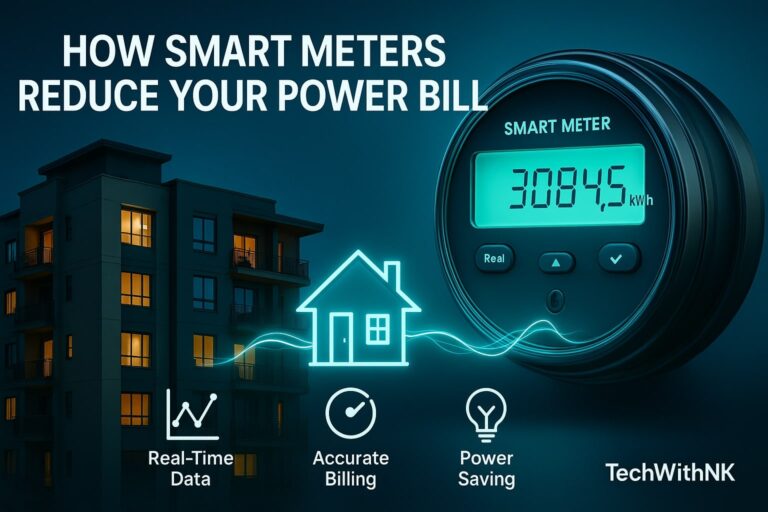🌐 Introduction – The 5G Revolution Begins
The world of connectivity is evolving faster than ever. 5G technology—the fifth generation of wireless communication—represents a major leap from 4G LTE. With ultra-fast speeds, minimal latency, and massive device connectivity, 5G is not just an upgrade—it’s the foundation for the future of smart cities, autonomous vehicles, industrial automation, and immersive virtual experiences.
In this blog, we’ll explore the key features of 5G technology, how it works, and the progress of 5G technology implementation in India by 2025.
⚙️ What is 5G Technology?
5G (Fifth Generation Mobile Network) is the latest standard for mobile communication, designed to deliver:
Faster data transfer speeds (up to 10 Gbps)
Lower latency (as low as 1 millisecond)
Higher network capacity (to connect billions of IoT devices)
Improved reliability and energy efficiency
5G is not just about faster internet; it’s about enabling intelligent, connected systems for everything from healthcare to transportation.

🌟 Top 10 Features of 5G Technology
Let’s break down the main features of 5G technology that make it revolutionary:
1. ⚡ Ultra-High Data Speeds
5G offers data speeds up to 100× faster than 4G, reaching as high as 10 Gbps in ideal conditions. This means downloading a 4K movie takes seconds instead of minutes.
2. 🕒 Ultra-Low Latency
Latency is the time delay between sending and receiving data. 5G reduces this delay to 1 millisecond, making it perfect for applications like autonomous cars and remote surgeries.
3. 🌍 Massive Device Connectivity
A key feature of 5G technology is its ability to connect up to 1 million devices per square kilometer—crucial for the Internet of Things (IoT) ecosystem.
4. 🧠 Network Slicing
5G can create virtual network slices—separate, customized network sections for specific use cases (e.g., healthcare, entertainment, or smart homes).
5. 🔋 Improved Energy Efficiency
5G networks consume less energy per bit of data transferred, supporting sustainable communication technologies.
6. 📶 Enhanced Mobile Broadband (eMBB)
This feature ensures seamless 4K/8K streaming, AR/VR gaming, and video conferencing, even in densely populated areas.
7. 🏭 Ultra-Reliable Low-Latency Communication (URLLC)
Enables real-time operations for industrial robots, drones, and mission-critical systems where reliability and precision matter.
8. 🌆 Massive Machine Type Communication (mMTC)
5G allows millions of smart sensors and IoT devices to operate simultaneously, supporting smart homes, agriculture, and logistics.
9. 🛰️ Beamforming Technology
Advanced antennas focus the 5G signal directly toward users, increasing data rates and network efficiency.
10. 🔐 Stronger Security and Encryption
5G networks integrate advanced encryption standards, AI-driven threat detection, and secure authentication protocols to protect user data.

🇮🇳 5G Technology in India: Current Scenario
India officially launched 5G technology in October 2022, marking a turning point in digital connectivity. Telecom giants like Jio, Airtel, and Vi (Vodafone Idea) have been aggressively expanding their 5G coverage across urban and semi-urban regions.
By 2025, 5G is expected to cover over 80% of India’s population, transforming industries such as:
Healthcare: Real-time telemedicine and remote patient monitoring
Education: Immersive AR/VR-based learning
Manufacturing: Smart factories and robotics
Transportation: Smart traffic systems and connected vehicles
Agriculture: Smart irrigation and drone-based crop monitoring
🏗️ 5G Technology Implementation in India 2025
The implementation of 5G technology in India 2025 is guided by the Digital India Mission and Atmanirbhar Bharat (Self-Reliant India) initiatives. Let’s look at the roadmap:
1. Infrastructure Expansion
India’s telecom providers are upgrading their existing infrastructure with 5G towers, small cells, and fiber networks for nationwide coverage.
2. Spectrum Allocation
The government has allocated mid-band and mmWave spectrum to telecom operators for high-speed and reliable connections.
3. Make-in-India Push
Companies like Reliance Jio and Tata Communications are developing indigenous 5G equipment, reducing dependency on foreign suppliers.
4. Rural Connectivity
By 2025, 5G is expected to reach rural and remote villages, enabling smart agriculture, e-health, and digital education platforms.
5. Private 5G Networks
Enterprises in automotive, mining, and manufacturing are adopting private 5G networks for automation and real-time analytics.

🔮 How 5G Will Transform India’s Futur
5G is not just a communication upgrade—it’s a technological backbone for India’s digital future. From enabling autonomous vehicles and AI-powered smart cities to cloud gaming and real-time translation, the opportunities are endless.
The integration of AI, IoT, cloud computing, and edge computing with 5G will accelerate India’s transition toward Industry 4.0.
📊 Comparison: 4G vs Features of 5G Technology
| Feature | 4G LTE | 5G Technology |
|---|---|---|
| Speed | Up to 100 Mbps | Up to 10 Gbps |
| Latency | 30–50 ms | 1 ms |
| Device Connectivity | 10,000/km² | 1 million/km² |
| Network Type | Broadband Internet | Smart IoT Networks |
| Technology Base | OFDMA | Massive MIMO, mmWave, Beamforming |
📱 5G-Enabled Devices in India (2025)
By 2025, most mid-range smartphones in India will support 5G connectivity. Brands like Samsung, OnePlus, Xiaomi, Realme, and Apple are releasing 5G-ready phones under ₹15,000–₹25,000, making the technology affordable for all.
Additionally, 5G is powering:
Smart TVs and IoT home devices
Autonomous delivery drones
Real-time security cameras
Cloud-based gaming systems
Challenges in 5G Implementation
Despite rapid progress, India still faces a few challenges:
High infrastructure cost for rural deployment
Limited availability of mmWave spectrum
Need for skilled workforce for 5G installation and maintenance
Energy demands for large-scale networks
However, with government initiatives and private investments, these challenges are being actively addressed.
Why 5G Is Called a Revolutionary and Technology
5G isn’t just faster internet—it’s a revolutionary leap that connects everything around us.
With powerful features like ultra-low latency, massive IoT support, and lightning-fast speeds, 5G opens doors to futuristic innovations such as driverless cars, smart cities, and real-time healthcare.
It’s no surprise that experts call it a game-changing technology shaping India’s digital future.
📈 The Road Ahead
As India heads toward a digitally empowered economy, 5G will play a central role in boosting productivity, innovation, and connectivity. By 2025, 5G technology in India will not only enhance user experience but also empower sectors like defense, healthcare, and space communication.
🔑 Conclusion-Features of 5G Technology
The features of 5G technology mark a defining chapter in India’s digital journey. As 5G technology implementation in India 2025 reaches its peak, industries and citizens alike will experience unprecedented speed, efficiency, and innovation.
India’s 5G revolution is not just about faster internet—it’s about building a smarter, connected, and sustainable future for everyone.
what are the key features of 5g technology
The key features of 5G technology include ultra-high speed, low latency, network slicing, massive IoT connectivity, and improved security.
What are the challenges of 5G implementation in India?
High infrastructure cost, spectrum allocation issues, and the need for rural network expansion are key challenges.










